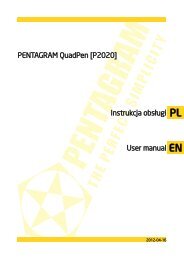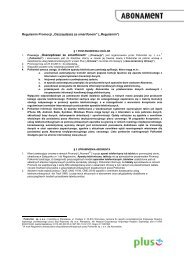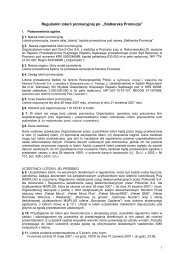Korytarz ekologiczny doliny Odry pdf
Korytarz ekologiczny doliny Odry pdf
Korytarz ekologiczny doliny Odry pdf
You also want an ePaper? Increase the reach of your titles
YUMPU automatically turns print PDFs into web optimized ePapers that Google loves.
Summary<br />
barges and, related to this, a construction plan to build several dams on the stretch where<br />
there are no such constructions (between Brzeg Dolny and the river mouth). Construction of<br />
those dams would lead to the destruction of majority of forests and other valuable biotopes<br />
in the area between the levees. The proposed restructuring of the Oder is a very high risk<br />
project economically speaking. Firstly – along the Oder there is a railway line, with a high,<br />
but unused, transport capacity. Secondly – in the situation caused by the growing repercussions<br />
of the global warming effect and the gradually increasing water deficits in some<br />
regions of the country (also in West Poland) the demand for water will grow (for the needs<br />
of people, agriculture, industry). A higher intake of water will lead to a drop in the river’s<br />
water level, which may therefore cease its use as a navigation channel.<br />
Similarly, huge damages to the valley biocenoses will be caused by the planned construction<br />
of the East-West waterway, through the Warta, Noteæ and Bydgoszcz channel and<br />
the Vistula and Bug rivers. This will particularly affect the area of peatbogs and flood-<br />
-meadows as well as populations of waterfowl (especially in the region of the S³oñsk<br />
reserve).<br />
Attempts should also be made to limiting the reinforcement of river banks only to the<br />
most endangered parts of the rivers of the Oder catchment basin (towns, settlements, concave<br />
arcs). It is recommended to use bio-technical reinforcements, rock filling or openwork<br />
slabs.<br />
Protection of the natural environment of the ecological corridor of the Oder river<br />
1. Various steps should be made towards:<br />
• raising of ground water levels in areas where it had dropped, following human activity,<br />
bottom erosion or drought,<br />
• the restoration of biotopes, which have been lacking in individual tracts of the river,<br />
• the creation of artificial small waterbodies in the Oder valley, using, for example, used<br />
gravel pits, and the creation of isles on those reservoirs, which will be particularly<br />
important as new breeding sites for waterfowl,<br />
• reconstruction and construction of small retention reservoirs in the Oder tributaries.<br />
2. If the construction of Malczyce dam is performed, it is proposed to use part of the<br />
dammed waters to irrigate areas in the Oder valley, downstream of the dam, using the network<br />
of ox-bows.<br />
3. In the parts, where the ground water level has dropped significantly, weirs should be<br />
built on the Oder tributaries – around their mouths – and water should be carried by channels<br />
to the Oder valley area.<br />
4. The backfilling of the ox-bows and levelling of flood terraces should be abandoned.<br />
5. The possibility of creating isles, using suitable ox-bows, should be considered.<br />
6. An optimal solution is to maintain as high as possible diversity of ox-bows, such as:<br />
ox-bows joined with the Oder at the upper end, at the lower end, at both ends, ox-bows<br />
cut-off from the river, joined with the river only during high water periods; differentiation<br />
221



![PENTAGRAM Cerberus [P 6367] Installation and Operation Manual](https://img.yumpu.com/49786948/1/184x260/pentagram-cerberus-p-6367-installation-and-operation-manual.jpg?quality=85)



![PENTAGRAM Cerberus [P 6361] Quick Guide](https://img.yumpu.com/43449286/1/185x260/pentagram-cerberus-p-6361-quick-guide.jpg?quality=85)








